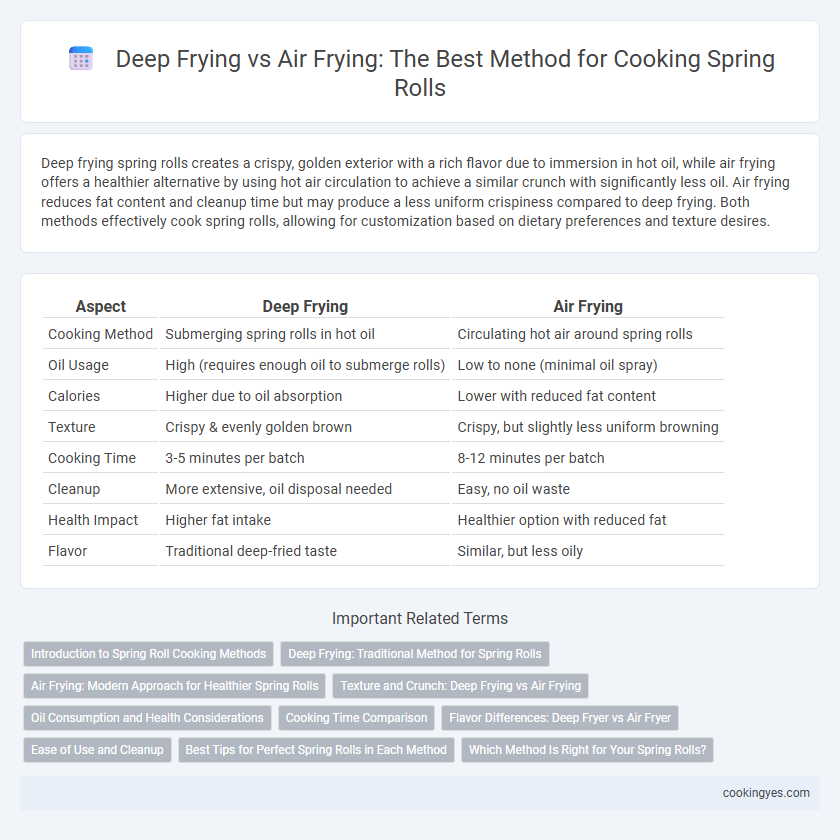Deep frying spring rolls creates a crispy, golden exterior with a rich flavor due to immersion in hot oil, while air frying offers a healthier alternative by using hot air circulation to achieve a similar crunch with significantly less oil. Air frying reduces fat content and cleanup time but may produce a less uniform crispiness compared to deep frying. Both methods effectively cook spring rolls, allowing for customization based on dietary preferences and texture desires.
Table of Comparison
| Aspect | Deep Frying | Air Frying |
|---|---|---|
| Cooking Method | Submerging spring rolls in hot oil | Circulating hot air around spring rolls |
| Oil Usage | High (requires enough oil to submerge rolls) | Low to none (minimal oil spray) |
| Calories | Higher due to oil absorption | Lower with reduced fat content |
| Texture | Crispy & evenly golden brown | Crispy, but slightly less uniform browning |
| Cooking Time | 3-5 minutes per batch | 8-12 minutes per batch |
| Cleanup | More extensive, oil disposal needed | Easy, no oil waste |
| Health Impact | Higher fat intake | Healthier option with reduced fat |
| Flavor | Traditional deep-fried taste | Similar, but less oily |
Introduction to Spring Roll Cooking Methods
Deep frying spring rolls produces a crispy texture and golden appearance by immersing them in hot oil, resulting in a rich flavor profile that many traditional recipes favor. Air frying offers a healthier alternative, using hot air circulation to cook spring rolls with significantly less oil while maintaining a crunchy exterior and a tender interior. Choosing between these methods depends on desired taste, texture, and dietary preferences, balancing indulgence with health-conscious cooking.
Deep Frying: Traditional Method for Spring Rolls
Deep frying remains the traditional method for cooking spring rolls, delivering a crispy, golden-brown exterior and a rich, savory flavor that air frying often cannot fully replicate. The high heat of deep frying quickly seals the spring roll wrapper, locking in moisture and ensuring a tender, flavorful filling. Although deep frying uses more oil, it produces the authentic texture and taste that many culinary experts and enthusiasts prefer for classic spring rolls.
Air Frying: Modern Approach for Healthier Spring Rolls
Air frying spring rolls reduces oil consumption by up to 80%, resulting in lower calorie and fat content while maintaining a crispy texture. This modern cooking method uses rapid hot air circulation to evenly cook spring rolls, preserving their flavors and nutrients without the excess greasiness of deep frying. Air frying offers a healthier alternative that supports weight management and cardiovascular health without compromising the traditional taste and crunch.
Texture and Crunch: Deep Frying vs Air Frying
Deep frying spring rolls produces a consistently crispy and golden exterior with a rich, oily texture that enhances flavor and mouthfeel. Air frying offers a lighter, less greasy crunch by circulating hot air, making spring rolls crisp without excess oil but sometimes less uniform in texture. Texture enthusiasts often prefer deep frying for its traditional crunch, while air frying appeals to those seeking a healthier alternative with a lighter crisp.
Oil Consumption and Health Considerations
Deep frying spring rolls consumes significantly more oil, leading to higher calorie content and increased fat intake, which can contribute to heart disease and obesity. Air frying uses little to no oil while still achieving a crispy texture, making it a healthier option with reduced saturated fat and cholesterol levels. Choosing air frying over deep frying supports improved cardiovascular health and weight management by minimizing unhealthy oil consumption.
Cooking Time Comparison
Deep frying spring rolls typically takes 3 to 5 minutes to achieve a crispy, golden exterior, providing even heat distribution for thorough cooking. Air frying requires about 8 to 12 minutes at 400degF (205degC), using hot air circulation to crisp the rolls with less oil and reduced fat content. The cooking time difference reflects the balance between oil immersion and air circulation methods, impacting texture and health considerations.
Flavor Differences: Deep Fryer vs Air Fryer
Deep frying spring rolls produces a rich, crispy exterior with a pronounced savory flavor due to oil absorption and Maillard reactions, enhancing the taste experience. Air frying creates a lighter, less greasy texture with slightly milder flavor intensity, preserving the natural ingredients' freshness. The choice affects flavor complexity and texture, making deep frying preferable for indulgence and air frying suitable for healthier options.
Ease of Use and Cleanup
Deep frying spring rolls requires large amounts of oil, making the cleanup process more time-consuming due to greasy residue and oil disposal. Air frying offers a convenient alternative with minimal oil usage, resulting in an easier cleanup and less mess around the kitchen. The air fryer's simple design and fast cleanup make it a user-friendly option, especially for those prioritizing convenience and health.
Best Tips for Perfect Spring Rolls in Each Method
Deep frying spring rolls ensures a crispy, golden exterior and evenly cooked filling by maintaining oil temperature around 350degF, preventing sogginess with brief, controlled frying times. Air frying offers a healthier alternative by circulating hot air at 375degF for 10-15 minutes, requiring light brushing of oil to achieve a crunch similar to deep frying. For best results, avoid overcrowding the pan or basket in either method to promote even cooking and preserve the spring roll's texture.
Which Method Is Right for Your Spring Rolls?
Deep frying spring rolls produces a crispier, golden exterior and a richer flavor due to the immersion in hot oil, making it ideal for achieving traditional texture and taste. Air frying offers a healthier alternative by using significantly less oil, reducing fat content while still delivering a crunchy result, perfect for calorie-conscious individuals. Choosing between deep frying and air frying depends on your preference for texture, health considerations, and the equipment available in your kitchen.
Deep frying vs Air frying for Spring roll cooking Infographic

 cookingyes.com
cookingyes.com